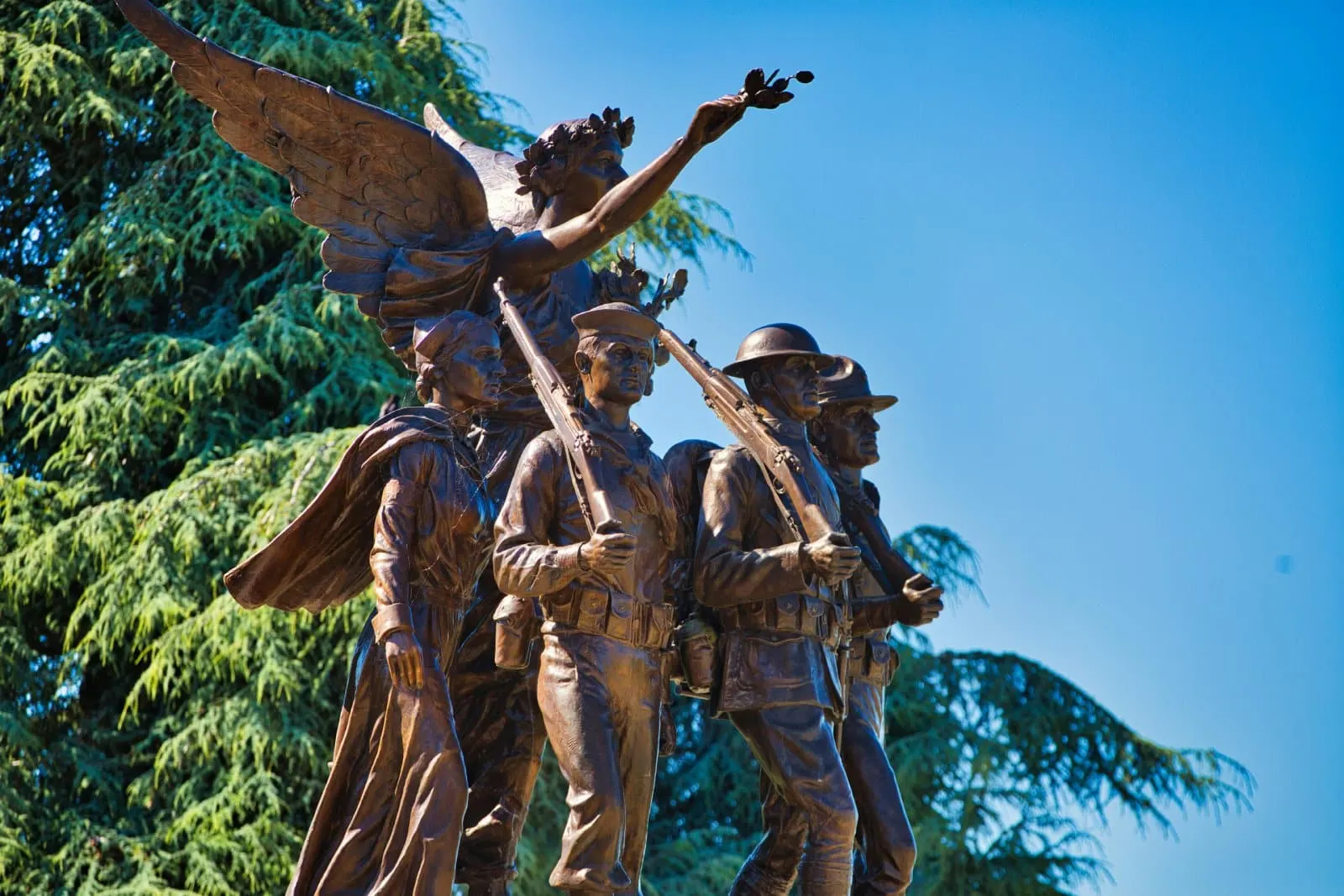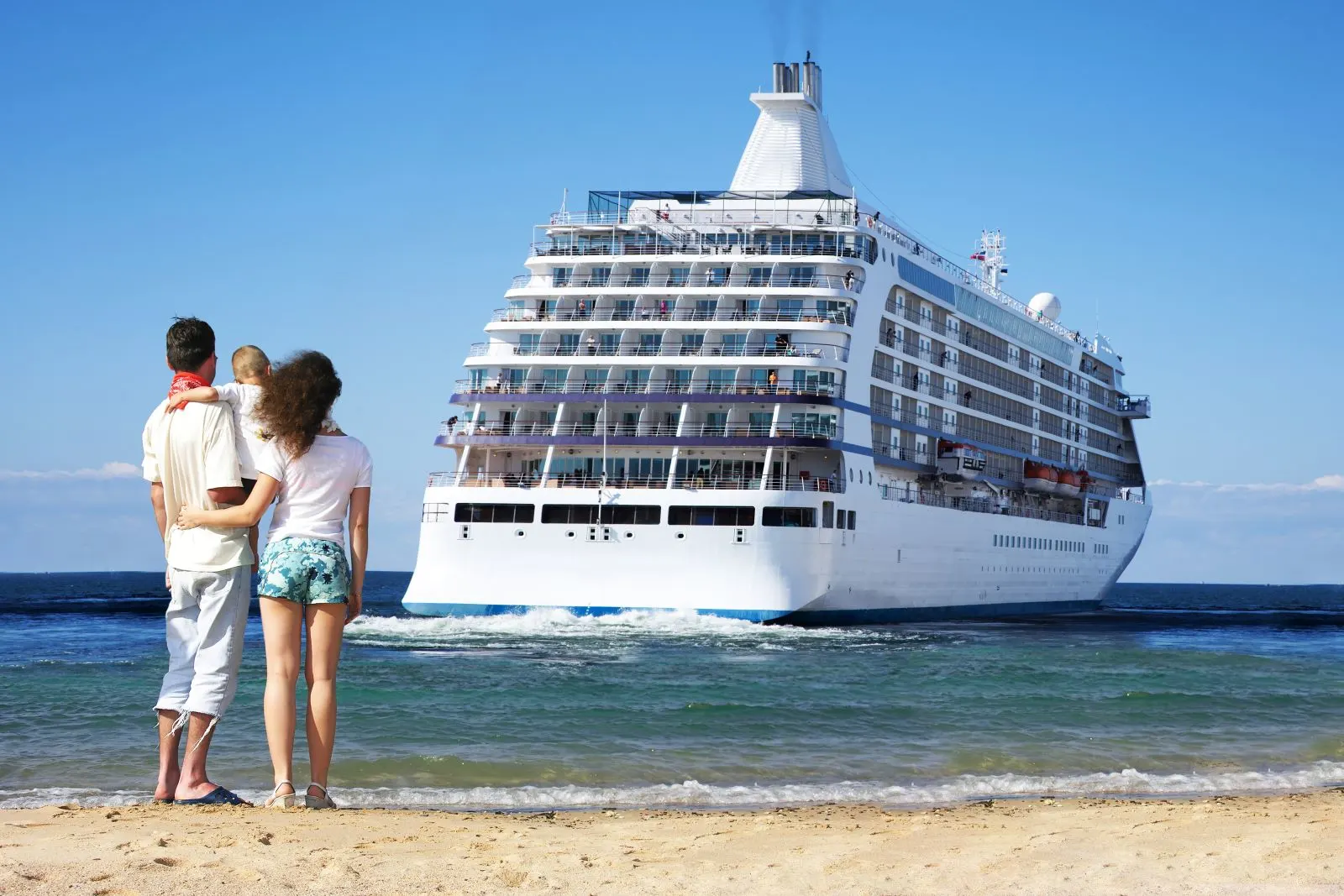Normandy is where history comes to life. Walk the beaches, visit the memorials, and explore the battlefields that shaped World War II and the world we live in today. From Omaha Beach to Pointe du Hoc, here’s your guide to uncovering Normandy’s most powerful WWII sites.
1. Omaha Beach and the Normandy American Cemetery

Image Credit: Shutterstock / EvaL Miko
As you stand on the sands of Omaha Beach, the gravity of history envelops you. This beach, a five-mile stretch of the Normandy coastline, was one of the primary landing sites for American troops during the D-Day invasion. Today, it’s a place of quiet reflection, where the only sounds are often the waves and the distant calls of seabirds. Walking along the beach, it’s hard not to be moved by what occurred here – the chaos, the bravery, the losses. The beach is wide and open, starkly contrasting the images of that fateful day in 1944.
A short distance away, the Normandy American Cemetery and Memorial stands as a solemn tribute to the American soldiers who lost their lives. The cemetery, spread over 172 acres, is a serene and meticulously maintained space overlooking the beach where many soldiers made the ultimate sacrifice.
Row upon row of white marble headstones – more than 9,000 in total – mark the resting place of these young men, each stone a poignant reminder of the cost of war. The visitor center provides a comprehensive and deeply moving account of the Normandy campaign, with personal stories, photographs, and artifacts that bring the history to life.
Insider’s Tip: Visit the cemetery during the late afternoon when the crowds have thinned and the setting sun casts a serene glow over the site.
2. Pointe du Hoc

Image Credit: Shutterstock / Dariusz Kleina
Your visit to Pointe du Hoc will take you to a dramatic cliff-top setting where the most heroic actions of D-Day took place. This promontory, jutting out into the English Channel, was a fortified German position and a key target for the American Rangers. They aimed to scale the 100-foot cliffs under heavy enemy fire and neutralize the artillery pieces that threatened the landing beaches.
Today, the site is a maze of bomb craters, shattered concrete, and rusting iron, showcasing the ferocity of the battle. A monument in the form of a simple granite dagger thrust into the ground is a tribute to the Rangers’ bravery.
As you walk through the bunkers and gun emplacements, it’s easy to imagine the intensity and danger of the assault. The visitor center offers a detailed account of the Rangers’ mission, complete with maps, photographs, and models. The panoramic view from the cliff top, overlooking the beaches and the vast expanse of the English Channel, is both breathtaking and sobering, a stark reminder of the strategic importance of this point.
Insider’s Tip: Wear sturdy shoes as the terrain is uneven and slippery, especially after rain.
3. Juno Beach Centre

Image Credit: Shutterstock / Franck Legros
Juno Beach, where Canadian forces landed, now hosts the Juno Beach Centre, a museum dedicated to Canada’s role in World War II. This modern facility commemorates the Canadian soldiers’ valor and educates visitors about Canada’s broader wartime efforts and sacrifices.
The Centre’s exhibits are thoughtfully curated, featuring interactive displays, wartime artifacts, and personal stories that vividly depict the Canadian experience during the war. The beach itself, now a tranquil stretch of sand, stands in contrast to its history, making it a reflective space to ponder the events of D-Day.
The Centre also focuses on educating younger generations, ensuring that the lessons and legacy of WWII are not forgotten. Outside, you can stroll along the same shoreline where Canadian troops once landed, a powerful experience that connects you directly to history. The Centre’s location also offers a beautiful coast view, adding a serene backdrop to your visit.
Insider’s Tip: Participate in a guided tour of the beach and the remnants of the Atlantic Wall fortifications for a more immersive experience.
4. Arromanches and the Mulberry Harbour

Image Credit: Shutterstock / olrat
In the small town of Arromanches, remnants of the Mulberry Harbour, an extraordinary feat of military engineering, still lie off the coast. These massive concrete structures were part of a temporary harbor built by the Allies to facilitate the rapid offloading of troops and supplies.
The town’s museum, Musée du Débarquement, provides an in-depth look at the construction and significance of this artificial harbor. Models, dioramas, and films within the museum illustrate the ingenuity and effort that went into creating this temporary port, crucial for the success of the landings.
Walking along the beach, you can see the remains of the Mulberry Harbour, partially submerged, a stark reminder of the scale of the D-Day operation. The town of Arromanches is charming, with its war memorials and informative plaques adding historical context to its picturesque streets and seaside ambiance. The 360 Circular Cinema, located on the cliffs above the town, offers a unique cinematic experience, with archival footage providing a 360-degree view of the Battle of Normandy.
Insider’s Tip: Visit the museum first to understand the significance of the harbor remains you’ll see on the beach.
5. The Caen Memorial Museum

Image Credit: Shutterstock / Jillian Cain Photography
When you visit the Caen Memorial Museum, you’re entering a space dedicated to understanding and reflecting on one of the most tumultuous periods in modern history. Known as the Peace Museum, it’s a place that not only chronicles the events of World War II but also delves into the causes and consequences of the conflict.
The museum’s extensive exhibits take you on a journey from the interwar period to the D-Day landings and beyond, highlighting the importance of peace in a world that once teetered on the brink of destruction. The narrative is enhanced by interactive displays, personal stories, and a wealth of artifacts that bring the history to life.
The museum also explores the Cold War era and the search for peace, making it a comprehensive resource for understanding 20th-century history. The beautifully landscaped gardens surrounding the museum provide a space for contemplation and reflection on the themes of war and peace.
Insider’s Tip: Allocate at least half a day for your visit, as the museum covers a vast array of exhibits and information.
6. Utah Beach and Museum

Image Credit: Shutterstock / olrat
Utah Beach, with its expansive sands and gentle dunes, belies the intense historical significance of this location. The Utah Beach Museum, situated at the very site of the D-Day landings, offers a poignant reminder of this beach’s pivotal role in World War II.
The museum’s collection is comprehensive, featuring an array of military vehicles, personal artifacts, and immersive dioramas that vividly recount the events of June 6, 1944. As you explore the exhibits, you’ll gain a deeper understanding of the planning and execution of the landings and the immense challenges faced by the Allied forces.
The museum also pays tribute to the airborne operations crucial to the success of the landings with detailed accounts and displays. Stepping outside onto Utah Beach, the contrast between the peaceful present and its turbulent past becomes strikingly evident, offering a moment for reflection on the sacrifices made on these shores.
Insider’s Tip: Look out for the original B-26 Marauder aircraft displayed at the museum, a rare piece of history.
7. Pegasus Bridge and Museum

Image Credit: Shutterstock / Pete Stuart
Pegasus Bridge, a site synonymous with one of the most daring operations of the D-Day landings, holds a special place in the annals of military history. The capture of this bridge by British airborne troops was a feat of extraordinary bravery and strategic importance.
The Pegasus Bridge Museum not only tells the story of this daring assault but also pays homage to the men who carried it out. As you explore the museum, you’ll encounter a full-size replica of a Horsa glider, similar to those used in the operation, and various artifacts that bring the story to life.
The original bridge, now replaced and displayed on the museum grounds, is a tangible link to history. The museum’s detailed exhibits and multimedia presentations provide a comprehensive understanding of the operation’s significance in the context of the Normandy landings.
Insider’s Tip: Visit the café nearby, Café Gondrée, the first house in France to be liberated during the D-Day landings.
8. The Battle of Normandy Memorial Museum in Bayeux

Image Credit: Shutterstock / Andy Sutherland
The Battle of Normandy Memorial Museum in Bayeux offers a compelling narrative of the 100-day campaign that followed the D-Day landings. As you walk through the museum, you’ll be taken on a chronological journey that details the military strategies and operations and delves into the conflict’s human experiences.
The museum’s extensive collection of military equipment, uniforms, and personal accounts vividly portrays the battle’s intensity and complexity. The detailed maps and models help visualize the scale and scope of the operations, while personal stories and artifacts add a deeply human dimension to the events. This museum is essential for anyone seeking to understand the full scope of the Battle of Normandy beyond the initial landings.
Insider’s Tip: Combine your visit with a trip to the famous Bayeux Tapestry and the Bayeux War Cemetery for a full day of historical exploration.
9. Sainte-Mere-Eglise and the Airborne Museum

Image Credit: Shutterstock / M.J.J. de Vaan
In the small town of Sainte-Mere-Eglise, the Airborne Museum is a tribute to the 82nd and 101st Airborne Divisions’ crucial role in the D-Day landings. This museum brings to life the story of the paratroopers who played a pivotal role in the liberation of the town, one of the first to be freed by the Allies.
The museum’s exhibits, including a C-47 aircraft and a WACO glider, vividly portray the airborne operations. Personal items and memorabilia displayed throughout the museum offer a poignant glimpse into the lives of the soldiers who fought here.
The town of Sainte-Mère-Église itself holds a special place in history, with its iconic church where a dummy paratrooper hangs from the spire, commemorating the paratrooper who became entangled there during the landings. This visual representation adds a unique and personal dimension to the town’s liberation story. Together, the museum and the town create a comprehensive narrative of the airborne operations, their challenges, and their successes.
Insider’s Tip: Visit the church to see the stained glass window that honors the paratroopers and their sacrifice.
10. The Merville Battery and Museum

Image Credit: Shutterstock / Rudolf_Prchlik
The Merville Battery, a formidable German coastal fortification, played a significant role in the events of D-Day. The museum on-site offers an insightful look into the assault on the battery by British airborne troops, a key operation for protecting the eastern flank of the landings.
The museum has preserved the battery and its bunkers, allowing you to step into history and experience the conditions of the battlefield. Displays include a Dakota aircraft, artillery pieces, and detailed accounts of the assault, providing a comprehensive understanding of the strategic importance of this site.
Walking through the bunkers and examining the artillery pieces, you can almost feel the intensity of the battle that took place here. The museum does an excellent job of conveying the significance of the Merville Battery in the context of the Normandy landings, making it a must-visit for anyone interested in military history.
Insider’s Tip: Explore the bunkers to understand soldiers’ conditions during the assault.
The Bottom Line

Image Credit: Pexels / Greg Thames
Your journey through the historic battlefields of Normandy is more than a trip through picturesque landscapes; it’s a walk through history, a tribute to courage and sacrifice. Each site, from the solemn beaches to the informative museums, offers a unique perspective on the events of D-Day and the Battle of Normandy.
As you explore these hallowed grounds, take a moment to reflect on the lessons of the past and the enduring importance of peace. Your visit honors the memory of those who fought and deepens your understanding of the significant events that shaped our world. Remember, you’re not just a visitor but a witness to history.
18 Countries That Don’t Want American Visitors

Image Credit: Shutterstock / InesBazdar
It’s time for a reality check, American travelers. As you pack your bags and head overseas, ready to stamp your passport, it’s becoming glaringly obvious that not every destination is thrilled to see you. 18 Countries That Don’t Want American Visitors
18 High-Crime Cities in the US You Should Avoid

Image Credit: Shutterstock / Iryna Inshyna
American cities promise rich culture and unforgettable experiences, but rising crime rates can catch travelers off guard. This guide helps you stay safe while fully enjoying your adventures. 18 High-Crime Cities in the US You Should Avoid
What Cruise Lines Don’t Want You to Know: 20 Candid Insights

Image Credit: Shutterstock / Pavel L Photo and Video
Thinking about booking a cruise for your next getaway? Let’s have a real talk first. While cruising might seem like a breezy way to see the world, there are a few not-so-sunny truths that might make you reconsider. What Cruise Lines Don’t Want You to Know: 20 Candid Insights
Featured Image Credit: Shutterstock / olrat.
The content of this article is for informational purposes only and does not constitute or replace professional advice.
The images used are for illustrative purposes only and may not represent the actual people or places mentioned in the article.
Tips for Trip Success
Book Your Flight
Find an inexpensive flight by using Kayak, a favorite of ours because it regularly returns less expensive flight options from a variety of airlines.
Book Your Hotel or Special Accommodation
We are big fans of Booking.com. We like their review system and photos. If we want to see more reviews and additional booking options, we go to Expedia.
You Need Travel Insurance!
Good travel insurance means having total peace of mind. Travel insurance protects you when your medical insurance often will not and better than what you get from your credit card. It will provide comprehensive coverage should you need medical treatment or return to the United States, compensation for trip interruption, baggage loss, and other situations.Find the Perfect Insurance Plan for Your Trip
PassingThru is a participant in the Amazon Services LLC Associates Program. As an Amazon Associate I earn from qualifying purchases.
To view PassingThru’s privacy policy, click here.
